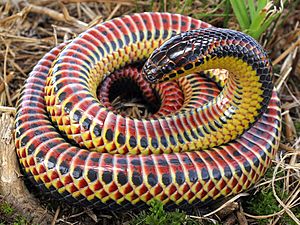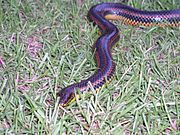Farancia erytrogramma facts for kids
Quick facts for kids Farancia erytrogramma |
|
|---|---|
 |
|
| A rainbow snake showing its belly colors | |
| Conservation status | |
| Scientific classification | |
| Genus: |
Farancia
|
| Species: |
erytrogramma
|
The rainbow snake (its scientific name is Farancia erytrogramma) is a large, non-poisonous snake that loves water. It's also sometimes called the eel moccasin. These snakes live only in the coastal areas of the southeastern United States. There are two types, or subspecies, of rainbow snakes, but one of them was thought to be extinct.
Contents
What's in a Name?
The scientific name erytrogramma comes from ancient Greek words. Erythros means "red," and gramma means "line" or "stripe." This name perfectly describes the snake's colorful look!
Other Names for the Rainbow Snake
People have given the rainbow snake many other names over time. Some of these include:
- horn snake
- red-lined snake
- red-lined horned snake
- red-sided snake
- sand hog
- sand snake
- striped wampum
How to Spot a Rainbow Snake
Rainbow snakes have smooth, shiny scales that are bluish-black on their backs. They have three bright red stripes running down their bodies. Their tails are short and have a pointy tip, which they sometimes use to explore. Older snakes might also have yellow colors on their sides and head.
Most adult rainbow snakes grow to be about 3 to 4 feet (91–122 cm) long. Some have even been found to be over 5 feet (168 cm) long! Female rainbow snakes are usually bigger than males.
- Gallery of Farancia erytrogramma images
Rainbow Snake Behavior
It's rare to see a rainbow snake because they are very shy. They spend most of their lives in water, hiding among plants or under other things. They are excellent swimmers and can also dig into mud and sand. If you happen to catch one, they are not aggressive and won't bite.
In some areas, like New Kent County in Virginia, many rainbow snakes are found in sandy fields near rivers, especially when farmers are plowing in the spring.
What Rainbow Snakes Eat
Rainbow snakes mainly eat eels. They also hunt small frogs, tadpoles, and salamanders. They swallow their prey whole, usually head first.
Reproduction and Life Cycle
Female rainbow snakes typically lay their eggs in July. They bury their eggs in sandy soil underground. A group of eggs, called a clutch, usually has about 20 eggs. However, very large females can lay more than 50 eggs! The baby snakes hatch in the late summer or fall.
Where Rainbow Snakes Live (Habitat)
Rainbow snakes live in many different watery places. These include cypress swamps, marshes, slow-moving streams, and sandy coastal areas. They especially like "blackwater" creeks, which get their dark color from decaying plants.
Where Rainbow Snakes are Found (Geographic Range)
You can find F. erytrogramma from southern Maryland all the way to southeastern Louisiana. This includes states like eastern Virginia, southeastern North Carolina, South Carolina, Georgia, northern Florida, Alabama, and Mississippi.
A small group of these snakes used to live near Lake Okeechobee in southern Florida. This group was thought to be extinct since October 5, 2011. However, in early 2020, a rainbow snake was seen in the Ocala National Forest in Florida. This sighting was confirmed as the first in 50 years for that area, meaning the "extinct" status might need to be re-evaluated!
Rainbow Snake Subspecies
There are two types, or subspecies, of F. erytrogramma:
- Farancia erytrogramma erytrogramma (Palisot de Beauvois, 1802) – This is the common rainbow snake.
- Farancia erytrogramma seminola (Neill, 1964) – This was known as the southern Florida rainbow snake. It was declared extinct on October 5, 2011. However, a sighting in Florida in 2020 suggests that it might still exist, and more studies are needed to find out how many are left.
Species Farancia erytrogramma at The Reptile Database
See also
 In Spanish: Serpiente arco iris para niños
In Spanish: Serpiente arco iris para niños




